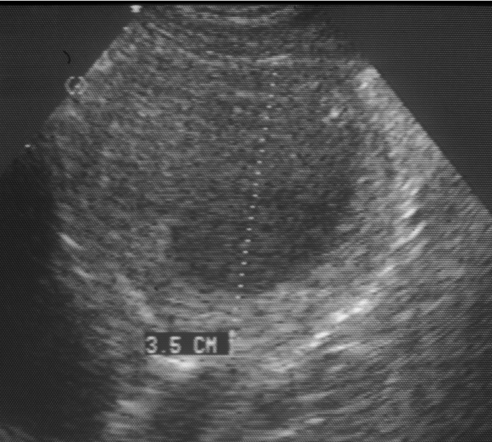2.11 Male small animal repro diseases
1/39
There's no tags or description
Looks like no tags are added yet.
Name | Mastery | Learn | Test | Matching | Spaced |
|---|
No study sessions yet.
40 Terms
When do penile spines in cats disappear?
Within 6 weeks castration
3 most common testicular neoplasia types and potential hormones produced
Sertoli cell tumour
Oestrogen → feminisation
Seminoma
(rarely oestrogen → feminisation)
Leydig (interstitial) cell tumour
Testosterone
Why should cryptorchid testicles be castrated?
More susceptible to torsion and malignant neoplasia
3 haematological changes of feminisation
Oestrogen depresses the bone marrow:
Anaemia
Leukopenia
Thrombocytopenia
Testicular neoplasia gives the testes an enlarged size. How is this differentiated from infection/abscess/orchitis/torsion and scrotal hernia?
Infection etc → pain
Scrotal hernia → undefined mass
4 signs of orchitis or epididymitis
Epididymal enlargement (+ small/firm testicle if chronic)
Pain or oedema
Abscessation via scrotum → purulent material
Septic peritonitis (due to rupture) → systemic malaise
3 origins of orchitis/epididymitis
Most common - urinary tract (UTI)
Direct penetration (e.g. bite)
Haematogenous spread (unlikely)
How does a doppler ultrasound help diagnose testicular torsion?
No blood flow seen on doppler in torsion
Causes of paraphimosis (4)
Nonerect penis protrudes from prepuce and cannot be retracted/retained normally
Narrow preputial orifice
Penile enlargement - prevents retraction
Abnormally short prepuce
E.g. preputial tissue contracts caudally following trauma
Weak preputial or retractor penis muscles
Medical treatments for paraphimosis (5)
Replacement
Lubrication
Hyperosmolar solutions - reduce penile size
Heat or cold - reduce penile size
Urethral catheter
Surgical treatments for paraphimosis (4)
Enlargement of preputial opening
Phallopexy
fix penis to preputial mucosa
Preputial lengthening or reconstruction
Often in conjunction with phallopexy
Partial penile amputation (complicated)
How do you surgically treat phimosis in dogs and cats? (2)
Full thickness V shaped incision and suture away from anus → widen preputial opening
Dogs - dorsal preputial surface
Cats - ventral preputial surface
Priapism definition
Persistent erection of >4 hours not associated with sexual excitement
4 potential associations with priapism
Trauma
Perineal abscess
Neurological disease
Neoplasia
2 categories of priapism (in humans)
Non ischaemic - not painful
Entire penis partially rigid
Ischaemic (emergency) - penile pain and necrosis
Painful rigid shaft
Soft glans
Surgical treatment of ischaemic priapism in dogs and cats
Penile amputation + urethrostomy:
Dog - scrotal urethrostomy
Cat - perineal urethrostomy
6 types of penile soft tissue tumours
Transmissible venereal tumour (TVT)
Squamous cell carcinoma (SCC)
Papilloma
Lymphoma
Mast cell tumour (MCT)
Adenocarcinoma
3 types of os penis tumours
Osteosarcoma
Ossifying fibroma
Chondrosarcoma
Which 2 types of penile tumours can be treated without any penile amputation?
Transmissible venereal tumour and lymphoma
Chemo + medical treatment
How do you treat most penile tumours?
Partial penis amputation or complete amputation + scrotal urethrostomy
Except TVT + lymphoma
Penile injury 3 presenting signs
Haemorrhage (most common)
Dysuria
Urine extravasation
Hypospadias
Failure of urogenital fold fusion (on ventral penis) → incomplete penile urethra
Why is it important to find the origin of preputial discharge?
Prepuce - more localised
External urethral orifice - can be either urinary or repro origin
4 prostatic diseases in a dog
Benign prostatic hypertrophy (BPH) - most common
Prostatitis or abscessation
Prostatic cysts
Neoplasia
What demographic is benign prostatic hypertrophy typically associated with?
Older entire male dogs - testosterone dependent disease
Normal aging change may contribute to clinical disease
3 signs of BPH
Uniform prostatic enlargement
Dyschezia
Occasional dysuria
Sometimes haematuria or urethral bleeding
3 medical treatments for BPH
Antiandrogens (reduce testosterone)
Deslorelin (unlicenced)
implant lasts 6 months in dogs V 1-4 years in ferrets
Faecal softeners (dyschezia)
(Oestrogens - but not recommended due to risk of squamous metaplasia)
Distinguishing prostatomegaly BPH and prostatitis (± abscessation)
BPH - firm prostate
Prostatitis - softer prostate due to abscess capsule
Rupture can lead to septic peritonitis
How is persistent frenulum treated in dogs?
Sectioning under GA
penis and prepuce should separate after puberty
3 characteristics of prostate ultrasound during prostatitis
Appears multiloculated (multiple chambers)
Flocculant (cloudy), anechoic (black) fluid
Large hyperechoic capsule

3 types of prostatic abscess drainage
Omentalisation
Flush fluid and bring omentum in cavity for blood supply and further drainage
Closed system drainage
Ultrasound guided, manually put drain in
Marsupialisation
Obsolete, create hole through skin for drainage
2 goals of prostatitis treatment
Antibiosis
Removal of secretory function → glandular reduction
Why is partial prostatectomy rarely done to treat prostatitis? (2)
Complicated surgery
Only works for focal lesion away from urethra (otherwise risk of urethral harm)
Most common fluid in (para)prostatic cysts
Urine 20% of the time
Other names for prostatic and paraprostatic cysts
Prostatic = parenchymal
Paraprostatic = periprostatic
What do you always do when surgically treating a (para)prostatic cyst?
Biopsy cyst wall - check for malignancy
2 most common types of prostatic neoplasia
Prostatic adenocarcinoma
Prostatic/urethral transitional cell carcinoma
Which demographic of animal is prostatic neoplasia more common in?
Castrated animals
Most common metastasis site for prostatic neoplasia
Very aggressive - tend to metastasise and invade locally
Spinal metastasis → therefore bone formation
(different from spondylosis - more irregular in metastases)
Why is prostatectomy rarely done in prostatic neoplasia?
Very aggressive, tends to metastasise - very poor prognosis